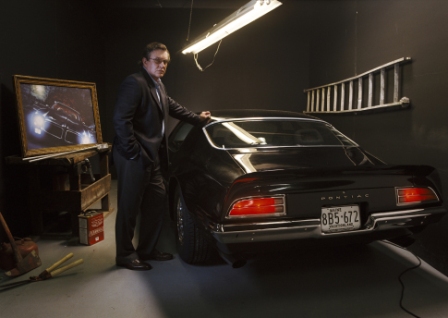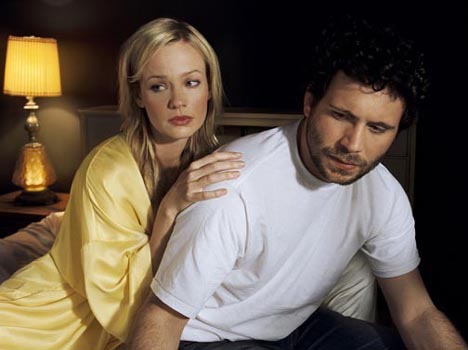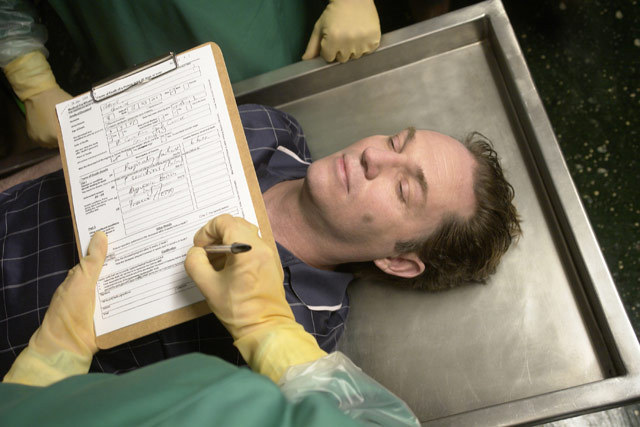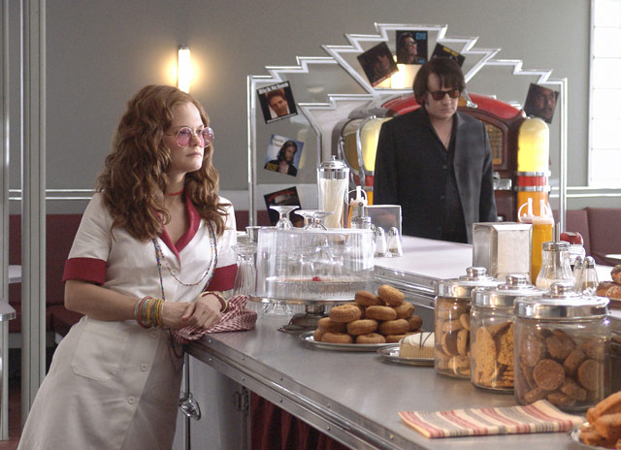Stephen King is the most influential voice in horror of the late 20th century. His books have been best sellers since his debut and have gone on to spawn numerous adaptations in film, TV, video games, and other media. King Of All Media looks at those adaptations, starting with his TV miniseries in chronological order. Each week Alejandra Gonzalez and Rob Dean will discuss a new miniseries project of King’s, with today’s installment being on the final four installments of 2006’s NIGHTMARES & DREAMSCAPES.
Rob Dean: King has been a part of other anthologies in the past. Whether it’s adapting his short stories or penning original entries, his work has appeared in CREEPSHOW, CREEPSHOW 2, CAT’S EYE, TALES FROM THE DARKSIDE: THE MOVIE—not to mention episodes of The X-Files, The Outer Limits, The Twilight Zone, Tales From the Darkside, and Monsters. NIGHTMARES & DREAMSCAPES remains, as of this date, the only anthology miniseries of which he’s ever been a part. Castle Rock, the new series on Hulu, is an anthology but one with each season having a self-contained story. Each of the installments in NIGHTMARES & DREAMSCAPES are unique and unrelated to each other.
Previously, we watched some good episodes and some less-than-good ones in the first half of the miniseries. Now we wrap up looking at this 2006 TV event with the final four entries. First up is “The Road Virus Heads North,” directed by Sergio Mimica-Gezzan, which centers on a popular horror writer (Tom Berenger) who receives some inconclusive but troubling news from his doctor following a colonoscopy. The author, Richard Kinnell, drives back from the hospital in Boston to his house in rural Maine, stopping along the way to buy a creepy painting at a yard sale. The painting has a sinister story behind it and soon Kinnell finds himself pursued by the shadowy madman depicted in the illustration.
I found “Road Virus” to be fairly middling. Berenger is fine as Kinnell, giving a lived-in and tired performance befitting a man who seems resigned to his fate. But the awkward and obvious parallels to King’s life (famed horror writer, similar age, lives in Maine, etc.) didn’t really add anything to the story—Kinnell being a horror writer doesn’t really factor into it, except maybe to explain why he would buy some art that people would find horrific? Mostly it becomes a very belabored tale of death stalking an aging man, and the need to come to grips with mortality. It’s also plagued with godawful music by miniseries composer Jeff Beal. This Us3-esque jazz music that, I guess, Kinnell listens to is so grating and totally incongruous with the events that it completely sucks out any sort of tension. This lack of fear and impending doom is compounded with the many uses of early 2000s’ filters, and a shutter-effect used instead of slow motion. It feels less like a dramatic effect and more like awkward padding. The entry is over all fine, it has some good moments and I think there’s actually a cool story within it, but too much of the execution works against the intent.
Ale—what did you think of “Road Virus Heads North?” Any favorite King anthologies on screen?

Alejandra Gonzalez: Rob, I completely agree with most of what you said (is that a first?).
I was fairly unmoved by “Road Virus Heads North,” but I thought some stuff in it was cool. I did like the story, and I found so many of the things in it reminded me of other things I love. For instance, I just revisited IN THE MOUTH OF MADNESS so I was getting real Sutter Cane vibes from Kinnell in the beginning which is always a good thing. I also thought a bunch about Dorian Gray watching this because of the painting that haunts Kinnell. So, there are definitely good things in it, but I just couldn’t find myself becoming invested in the episode. As for the music, I actually thought it was reminiscent of some of the sounds in Twin Peaks, which I liked but thought was severely out of place. Maybe that’s the thing, and I couldn’t find myself super invested because everything about this reminded me of something else. At the very least, I didn’t dislike it!
“The Fifth Quarter” is the next episode, directed by Rob Bowman (ELEKTRA, REIGN OF FIRE) and is about Willie Evans (Jeremy Sisto) who has just been released from prison. On the night of his release, his old cellmate, Barney, appears at his home and appears to have been shot. Barney tells Willie that he was involved in a heist and urges Willie to find the money since he wasn’t going to make it. The story follows Willie in his search for the missing pieces of the map that will lead him to the hidden money. To put it kindly, this might have been my least favorite episode of this bunch. While I think it was solid, it sticks out like a sore thumb among the others which are more concerned with supernatural events or other horror oriented themes. I just wasn’t expecting it, and I feel like if one were to watch these consecutively, it would be difficult to shift gears into something more heist-themed. Also, I hated the way this one looked. The muted, washed out color palate made me even less interested. I feel like I may be judging it too harshly because of what an outlier this episode is among the others, but that’s the name of the game! Did you like this one?

Rob Dean: I think this may be the only time Jeff Beal’s score for NIGHTMARES & DREAMSCAPES will be called “reminiscent of Angelo Badalamenti”—so there’s that at least!
I did like “The Fifth Quarter,” at least more than you did. It’s not great, to be certain, but there are a lot of good elements in it that I was interested. I agree that it tonally doesn’t work as an installment in this anthology. It’s cool in concept to mix it up with the other entries and have this noir story plunked down to show the range of King, but in practice it feels awkward and disappointing to suddenly divert into the crime motif. However, as a standalone story (not in the context of the miniseries), it’s pretty engaging and fun. I think, of all of the episodes, this is the one that could best benefit from a feature length adaptation (maybe Jim Mickle or someone) as there’s a lot of intriguing lowlife characters in it. It feels like a compacted Elmore Leonard book and I was suitably engaged with the pacing and story. The early 2000s filters are not great, but there are some fun stylistic choices (like having one of the thieves only appear in shadow). I also thought it was intriguing because the crux of the story is that Willie discovers Barney hooked up physically with Willie’s wife, Karen (Samantha Mathis). Willie is suitably angry about this in that tired crime story manner. But that anger goes away when Karen consoles Willie, pointing out she knows that Willie and Barney had physical relations in prison—and she doesn’t judge or begrudge it, she knows it was just people comforting each other, just like what she and Barney was doing. Now, prison sex is a tired cliche and a mildly detrimental trope obviously, but it was handled in such a surprising and sweet way that it almost redeems the inclusion. Willie realizes his wife is right, and is able to move past the hypocritical anger and jealousy. I don’t know, I was surprised by that turn and found it fairly novel.
Also novel? “Autopsy Room Four,” directed by Mikael Salomon and the next installment of this miniseries. Howard (Richard Thomas) is wheeled into the autopsy room after being pronounced dead of an apparent heart attack on the golf course. The only problem is that Howard isn’t dead. Instead he’s in a very deep resting state brought on by the venomous bite of a peculiar snake. The majority of the entry is Howard’s voiceover while the coroners muck about preparing to cut him open and the would-be corpse is frantically pleading to no one for it all to end and for them to realize he’s alive. This is a very fun story with great performances by the cast with pacing that never wears out its welcome, being perfectly suited for a small slice of the macabre. It feels in line with a tale from EC Comics, or an episode of Tales From The Crypt, along with old school mystery stories from the pulps. What makes it sing is the comedy of it all with oddball King lines about penises (the man loves a good erection reference) and the constant tension of where is this all going. At first I was put off that it wasn’t all being told from Howard’s POV (both in camerawork and with various edits and scenes taking place away from him), but that went away as it made sense within the context of the plot and making it visually interesting. There is some incredibly dodgy computer F/X that didn’t feel needed, but overall I thought “Autopsy Room Four” was a delight. Ale, what did you think about Howard and his Lazarus-like penis?

Alejandra Gonzalez: Hey! To be fair, the only thing that reminded me of Angelo Badalamenti were the saxophones in Beal’s score. But, still!
I absolutely loved “Autopsy Room Four.” I might be as bold as to say that it is my favorite thing we’ve covered for as long as we’ve been putting this column out. It was just so hilarious in ways I would typically find corny (the penis jokes you referenced, for instance). One moment that comes to mind is Howard’s solemn verbal contemplation of the mistakes he’s made in life being juxtaposed with the coroners fondling him for further examination. This was a subtle moment, but it successfully pulled off something that was clearly intended to be humorous. I also thought his assumed-to-be-dead body getting an erection mid-autopsy was a little ridiculous, but it made me laugh and you can tell this was a lot of fun for everybody involved. I was concerned at first because I thought this could get boring, but so much of the dialogue and what Howard was saying was great that it never lost my interest for even a moment.
The next and final episode in this anthology is “You Know They Got A Hell of a Band,” directed by Mike Robe, and is about a couple that gets lost on a road trip and finds themselves stumbling across a strange town that turns out to be heaven (or hell, more appropriately) for dead rock stars who want them to stay for their show. I felt indifferent about this, too. Actually, I would say I was leaning more towards dislike than indifference. Where “The Fifth Quarter” looked hideous to me because of its muted colors, this episode looked hideous to me because of the over-saturation. Also, literally none of the characters were likable so I was never anxious about what was happening to them. I particularly disliked the husband, played by Steven Weber, which I guess was the point, but it became rather frustrating after a while. The only real thing I liked about this was myself being curious about how they would portray some of my favorite dead musicians, but even that was underwhelming when they were on screen. We come across stars like a maniacal Janis Joplin, Roy Orbison, and even Buddy Holly to name a few. I don’t know what happens when you die, but for some reason all of these rock stars turned into really awful people and it just didn’t make sense because nothing was really ever explained about what really happens in this mysterious town. At least, they didn’t explain it well. Its like “this place is real dangerous and sinister! But can’t tell ya why!”. The only real insight we get is a very brief conversation the couple has with one of the towns residents, but we still don’t get much information then. Now I’m just frustrated. What did you think about this one, Rob?

Rob Dean: I was very let down that this was the final installment in an uneven but mostly good anthology. Always end strong, people! The look of this entry was incredibly bland and washed out, with lots of annoying stutter-like slow motion and lame music video filters and cut-ins. It also felt very reminiscent of “Crouch End” — a couple who constantly argues and where the guy is kind of a dick gets lost in a supernatural place with dire consequences. It probably would have behooved the producers to choose between those stories for adaptation rather than use both (lord knows there are plenty of other King short tales from which to choose). I thought that Kim Delaney was pretty good as the wife and seemed more put together than Claire Forlani in “Crouch End,” but still seemed to acquiesce to her jerk husband too much. The Rock ‘n Roll Heaven town didn’t make a ton of sense, partly because it was poorly explained and because it was not well executed. I think the idea of taking the dream of spending eternity with favorite artists in a neverending jam session and turning that into a grisly nightmare is a clever one, there’s just no real sense of what’s happening or why or what it means. There’s also no sense of justice — in that classic EC Comics vein — where the the guy obsessed with the old ways (old music, old cars, his father’s many musings) gets his dream but realizes only too late how horrible it is. Instead, Weber is pretty casual about the whole set up while Delaney is slowly losing her mind at being a hairdresser until the end of days. Lastly, the doubles for most of the musicians were…not great, and it felt like the producers only licensed maybe four songs (and even then just a few bars of each). Perhaps if the episode had better budget for the lookalikes and soundtrack, that could have added to the ambience and entertainment.
Over all, NIGHTMARES & DREAMSCAPES: FROM THE STORIES OF STEPHEN KING was, like all anthologies, a mixed bag. There were some highs, some lows, and a whole bunch of middles. Check out the ones we liked, though — I think you’ll be entertained. And tune in here in two weeks when we cover… 2009’s CHILDREN OF THE CORN? Hurray.
Tags: Buddy Holly, EC Comics, Elvis, Greta Scacchi, Horror Anthology, Janis Joplin, Jeff Beal, Jeremy Sisto, Kim Delaney, Mikael Salomon, Mike Robe, Nightmares & Dreamscapes, Nightmares and Dreamscapes, Richard Thomas, Ricky Nelson, Rob Bowman, Samantha Mathis, Sergio Mimica-Gezzan, Stephen King, Steven Weber, Tales From The Crypt, Tom Berenger


No Comments